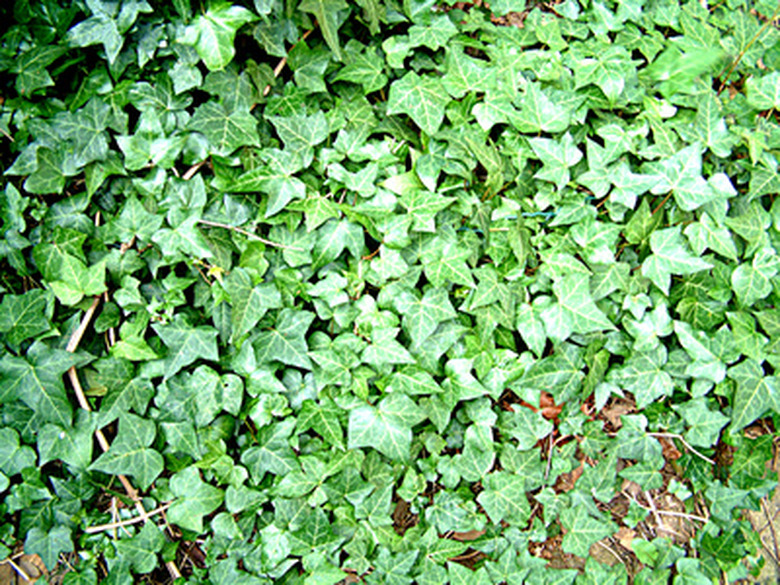How To Mow English Ivy
English ivy (Hedera helix) grows not just up brick walls, fences and trees, but also along the ground. If you have a low-growing English ivy plant, mow it to control its growth and encourage a fuller and thicker plant. Mowing also allows you a chance to clean out underneath your ivy where debris and leaves often accumulate. Over time, this area can become a breeding area for mosquitoes, slugs and other garden pests. It is best to mow your English ivy in the early spring, before new green growth begins.
Step 1
Set the mower on the highest setting, which is often done at each wheel by adjusting a lever to the highest setting. Alternately, you may need to unscrew the wheels and put them on the highest setting and then screw them back on.
- English ivy (Hedera helix) grows not just up brick walls, fences and trees, but also along the ground.
- If you have a low-growing English ivy plant, mow it to control its growth and encourage a fuller and thicker plant.
Step 2
Mow the ivy in rows in such a way that the ivy shoots outward, away from where you are going to mow next.
Step 3
Fertilize the freshly mowed English ivy with an all-purpose fertilizer. Follow the directions, including dosing amounts, on the label, but in general use about 2 tbsp. per square foot. Sprinkle the fertilizer evenly on the soil and do not get any on any remaining foliage.
Step 4
Water your mowed and fertilized ivy with 1 to 2 inches of water and continue to water it weekly until new green growth appears. This usually takes about three weeks.
- Mow the ivy in rows in such a way that the ivy shoots outward, away from where you are going to mow next.
- Water your mowed and fertilized ivy with 1 to 2 inches of water and continue to water it weekly until new green growth appears.
English Ivy Circling A Tree Kill The Tree?
English ivy (Hedera helix) is a member of the Arilia, or ginseng, family. This evergreen leafy vine enjoys shade in woodlands and forests and can be found along coastal regions and marshes as well. Leaves are lobed with three or five points and usually variegated in color with shades of green and white. These little attachments are so strong that they often need to be removed from walls with sandblasting. This leaves the tree looking like a stalk of broccoli with a head at the top of the tree. Leave the ivy intact on the tree, since removing it can cause the hold fasts to pull off pieces of bark, further weakening the tree.
- English ivy (Hedera helix) is a member of the Arilia, or ginseng, family.
- These little attachments are so strong that they often need to be removed from walls with sandblasting.
English Ivy Circling A Tree Kill The Tree?
English ivy (Hedera helix) is a member of the Arilia, or ginseng, family. This evergreen leafy vine enjoys shade in woodlands and forests and can be found along coastal regions and marshes as well. Leaves are lobed with three or five points and usually variegated in color with shades of green and white. These little attachments are so strong that they often need to be removed from walls with sandblasting. This leaves the tree looking like a stalk of broccoli with a head at the top of the tree. Leave the ivy intact on the tree, since removing it can cause the hold fasts to pull off pieces of bark, further weakening the tree.
- English ivy (Hedera helix) is a member of the Arilia, or ginseng, family.
- These little attachments are so strong that they often need to be removed from walls with sandblasting.
Things Needed
- Screwdriver
- Fertilizer
- Water
Tip
Older, more established ivy that has deep roots may not grow back as quickly as newer English ivy plants.
References
- The American Ivy Society: Questions and Answer
- Yardener.com: Caring for English Ivy
- Arlington Virginia Parks and Recreation: Choking Hazard
- University of Arkansas Cooperative Extension Service: Plant of the Week — English Ivy
- National Park Service Plant Conservation Alliance: English Ivy
- Fine Gardening: Hedera Helix
- Arlington Virginia Parks and Recreation: Choking Hazard
- University of Arkansas Cooperative Extension Service: Plant of the Week — English Ivy
- National Park Service Plant Conservation Alliance: English Ivy
- Fine Gardening: Hedera Helix
